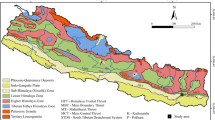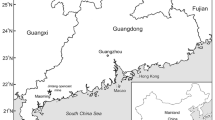Abstract
Fossil leaflet impression described here as a new species Rourea miocaudata sp. nov., showing close resemblance with the modern leaflets of Rourea caudata Planch. (Connaraceae R. Br.), has been recorded from the lower part of the Siwalik sediments (Dafla Formation, middle–upper Miocene) exposed at the road-cutting section of Pinjoli area in West Kameng district, Arunachal Pradesh. The important morphological characters of the fossil are its narrow elliptic leaflet, cuneate base, long caudate apex, entire margin, eucamptodromous to brochidodromous secondary veins, presence of intersecondary veins, percurrent and reticulate tertiary veins and orthogonally reticulate quaternary veins. This is the first authentic record of the occurrence of leaflet comparable to R. caudata of Connaraceae from the Cenozoic sediments of India and abroad. At present R. caudata does not grow in India and is restricted only in southeast Asia especially in China and Myanmar. This taxon probably migrated to these southeast Asian regions after lower Siwalik sedimentation (middle–upper Miocene) due to climatic change caused by post-Miocene orogenic movement of the Himalaya. The recovery of this species and other earlier-described evergreen taxa from the same formation, suggests the existence of a tropical, warm and humid climatic conditions during the depositional period.




Similar content being viewed by others
References
Angiosperm Phylogeny Group [APG] 2003 An update of the Angiosperm Phylogeny Group classification for the orders and families of flowering plants: APG II; Bot. J. Linn. Soc. 141 399–436.
Angiosperm Phylogeny Group [APG] 2009 An update of the Angiosperm Phylogeny Group classification for the orders and families of flowering plants: APG III; Bot. J. Linn. Soc. 161 105–121.
Bande M B and Prakash U 1986 The Tertiary flora of southeast Asia with remarks on its palaeoenvironment and phytogeography of the Indo-Malayan region; Rev. Palaeobot. Palynol. 49 203–233.
Brandis D 1971 Indian Trees; Bishen Singh, Mahenra Pal Singh, Dehradun.
Chirouze F, Dupont-Nivet G, Huyghe P, van der Beek P, Chakraborti T, Bernet M and Erens V 2012 Magnetostratigraphy of the Neogene Siwalik Group in the far eastern Himalaya: Kameng section, Arunachal Pradesh, India; J. Asian Earth Sci. 44 117–135.
Cronquist A 1981 An integrated system of classification of flowering plants; Columbia University Press, New York.
Dilcher D L 1974 Approaches to the identification of Angiospermous leaf remains; Bot. Rev. 40 1–157.
Heywood V H, Brummitt R K, Culham A and Seberg O 2007 Flowering plant families of the world; Royal Botanic Gardens, Kew.
Joshi A and Mehrotra R C 2003 A thelypteridaceous fossil fern from the Lower Siwalik of the East Kameng District, Arunachal Pradesh, India; J. Geol. Soc. India 61 483–486.
Joshi A and Mehrotra R C 2007 Megaremains from the Siwalik Sediments of West and East Kameng Districts, Arunachal Pradesh; J. Geol. Soc. India 69 1256–1266.
Joshi A, Tewari R, Mehrotra R C, Chakraborty P P and De A 2003 Plant remains from the Upper Siwalik sediments of West Kameng District, Arunachal Pradesh; J. Geol. Soc. India 61 319–324.
Khan M and Bera S 2007 Dysoxylum miocostulatum sp. nov. – a fossil leaflet of Meliaceae from the Lower Siwalik sediments of West Kameng district, Arunachal Pradesh, Eastern India; Indian J. Geol. 79 (3–4) 63–68.
Khan M A and Bera S 2010 Record of fossil fruit wing of Shorea Roxb. from the Neogene of Arunachal Pradesh; Curr. Sci. 98 (12) 1573–1574.
Khan M A and Bera S 2014a New lauraceous species from the Siwalik forest of Arunachal Pradesh, eastern Himalaya, and their palaeoclimatic and palaeogeographic implications; Turk. J. Bot. 38 453–464.
Khan M A and Bera S 2014b On some Fabeceous fruits from the Siwalik sediments (Middle Miocene–Lower Pleistocene) of Eastern Himalaya; J. Geol. Soc. India 83 165–174.
Khan M A, Bera S, Ghosh R, Spicer R A and Spicer T E V 2015 Leaf cuticular morphology of some angiosperm taxa from the Siwalik sediments (middle Miocene to lower Pleistocene) of Arunachal Pradesh, eastern Himalaya: Systematic and palaeoclimatic implications; Rev. Palaeobot. Palynol. 214 9–26.
Khan M A, De B and Bera S 2008 Fossil leaves resembling modern Terminalia chebula Retzius from the Lower Siwalik sediments of Arunachal Pradesh, India; Pleione 2 (1) 38–41.
Khan M A, Spicer R A, Bera S, Ghosh R, Yang J, Spicer T E V, Guo S, Su T, Jacques F and Grote P J 2014 Miocene to Pleistocene Floras and Climate of the Eastern Himalayan Siwaliks, and New Palaeoelevation Estimates for the Namling-Oiyug Basin, Tibet; Glob. Planet. Chang. 113 1–10.
Kumar G 1997 Geology of Arunachal Pradesh; Geol. Soc. India, Bangalore, pp. 1–217.
Mabberley D J 1997 The Plant-Book. A probable dictionary of the vascular plants; Press Syndicate of the University of Cambridge, UK.
Mehrotra R C, Liu X Q, Li C S, Wang Y F and Chauhan M S 2005 Comparison of the Tertiary flora of southwest China and northeast India and its significance in the antiquity of the modern Himalayan flora; Rev. Palaeobot. Palynol. 135 145–163.
Nandi O I, Chase M W and Endress P K 1998 A combined cladistic analysis of angiosperms using rbcL and non-molecular data sets; Ann. Missouri Bot. Gard. 85 137–212.
Prasad M and Pandey S M 2008 Plant diversity and climate during Siwalik (Miocene–Pliocene) in the Himalayan foot hills of western Nepal; Palaeontogr. Abt. B 278 13–70.
Reveal J L 2012 An outline of a classification scheme for extant flowering plants; Phytoneuron 37 1–221.
Smith A G and Briden J C 1979 Mesozoic and Cenozoic palaeocontinental maps; Cambridge University Press, Cambridge, 163p.
Srivastava R and Mehrotra R C 2009 Plant fossils from Dafla Formation, West Kameng district, Arunachal Pradesh; Palaeobotanist 58 33–49.
Takhtajan A 1969 Flowering plants origin and dispersal; Oliver and Boyd, Edinburgh, pp. 156–163.
Takhtajan A 1997 Diversity and classification of flowering plants; Columbia University Press, New York.
Xiwen L. and Walker D 1996 The Plant Geography of Yunnan Province, Southwest China; J. Biogeogr. 13(5) 367–397.
Acknowledgements
We acknowledge Department of Science and Technology, New Delhi (SR/S4/ES-67/2003) for financial assistance. We are thankful to Mr Sambhu Chakraborty, Senior Geologist, Geological Survey of India, Itanagar for help and cooperation during the collection of samples. Thanks are due to the authorities of Central National Herbarium, Sibpur, Howrah for permission to consult the Herbarium.
Author information
Authors and Affiliations
Corresponding author
Additional information
Corresponding editor: G V R Prasad
Rights and permissions
About this article
Cite this article
KHAN, M.A., BERA, S. First fossil evidence of Connaraceae R. Br. from Indian Cenozoic and its phytogeographical significance. J Earth Syst Sci 125, 1079–1087 (2016). https://doi.org/10.1007/s12040-016-0711-0
Received:
Revised:
Accepted:
Published:
Issue Date:
DOI: https://doi.org/10.1007/s12040-016-0711-0




